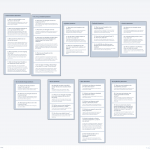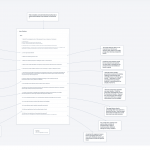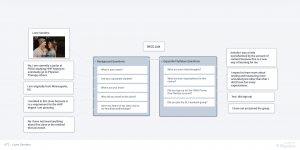And yes I just completed the survey.
Author: lssanders
Sanders-KT2
I just finished taking the survey as well. The whole process and making maps is starting to make more sense know that I’ve done it a time or two!
- Define descriptive and inferential statistics. What is the distinction between the two (provide examples of both)?
- A population would represent the entire possible group that is relevant to a survey. While a sample is only the select group that was actually chosen for said survey
- ex: Say we were to conduct a survey on the number of FHSU students that use the recreational services by passing out a survey in every HHP class on campus MWF. The population would be all FHSU students, while the sample would only be students who have an on campus class MWF.
- Define populations and samples. What is the distinction between the two (provide examples of both)?
- Descriptive Statistics Example: A table used to describe the average cost of different college tuitions
- Inferential statistics example: Taking a sample of jobs of students who graduates from FHSU in a certain department from last spring and inferring results from sample about students graduating in May.
- Define an independent and dependent variable. What is the distinction between the two (provide examples of both)?
- An independent variable is one that can and is manipulated by the experimenter, while the dependant variable is held constant for all trials of an experiment.
- ex: In an experiment we want to test how exercise affects test scores. The independent variable would be number of hours of exercise, while the dependent variable would be the test scores.
- What is the distinction between a discrete and a continuous variable (provide examples of both)?
- Discrete variables are when the measurements are set apart by a specific intervals on a scale. And continuous variables would be measurements that aren’t restricted to set intervals but could be any range of numbers
- Discrete ex: number in a household
Continuous: time
- What are the different levels of measurement? Provide examples of the different levels.
- The different levels to measurements include Nominal, Ordinal, Interval, and Ratio.
- Nominal ex: Table that organized based on gender
Ordinal ex: ranking a product on a scale of 1-5
Interval: Results of a standardized test score
Ratio: Temperature measurements in Kelvin
- What is DSRP?
- DSRP is a method/process of teaching, learning, and thinking that is aimed at helping students have a deeper understanding of information while also helping students transfer knowledge into their career rather than just a test.
- How is “Test” defined?
- According to the book a test for this class is any instrument or tool used for measurement
- How is “Measurement” defined?
- Measurement, while usually, quantitative, is the process of assigning a number to a person or characteristic of a performance or value.
Sanders-KT1
What is your name? Lane Sanders
Are you a graduate student? No, I am currently a junior at FHSU studying HHP hoping to eventually go to Physical Therapy school.
Where are you from? I am originally from Minneapolis, KS.
Why did you enroll in this class? I enrolled in this class because it is a requirement for the HHP degree I am pursuing.
Have you heard of my class and or my teaching methodology? No I have not heard anything about this class or the method that you teach.
What are your initial thoughts? Initially I was a little overwhelmed by the amount of content because this is a new way of learning for me.
What are your expectations for this course? I expect to learn more about testing and measuring more accurately but other than that I don’t have too many expectations.
Did you sign up for the FHSU Promo free Plectica account? Yes I did
Did you join the SL Facebook group? No I have not joined yet.



